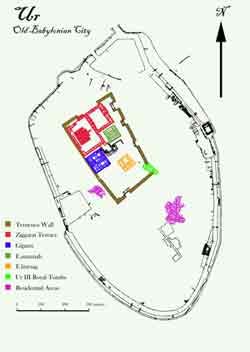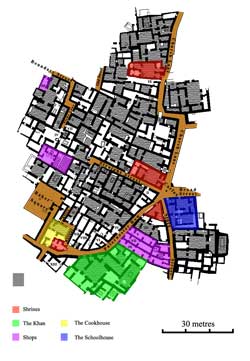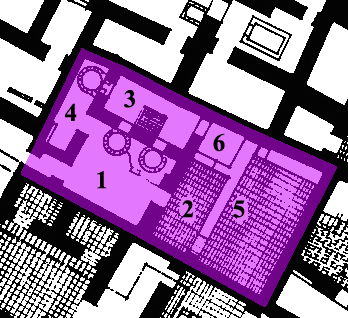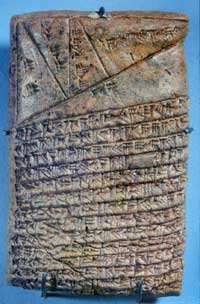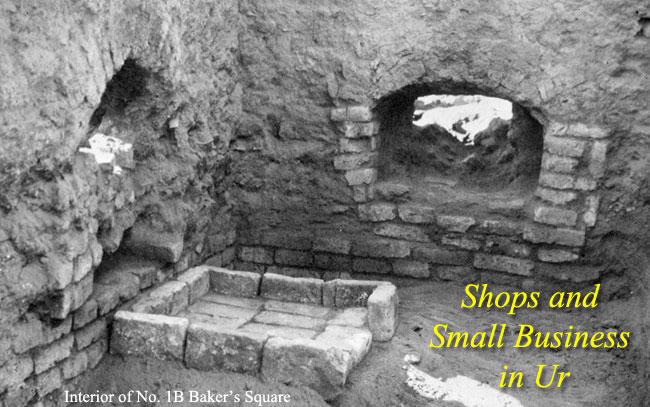
Shops and Businesses
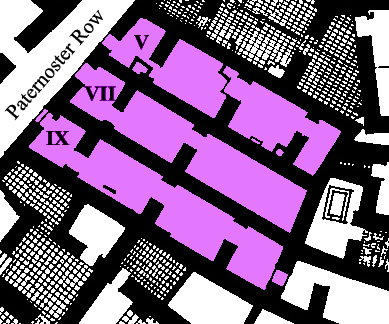 Shops and other commercial enterprises were relatively common in ancient Ur and a number have identified. They are generally long and very narrow buildings with a small room at the front and one or more storerooms or workshops at the back. Typical examples are the shops at No.’s 5, 7 & 9 Paternoster Row (Area AH). Woolley suggests that there may have been low windows at the front that served as counters for displaying goods. With shutters and awnings, these would have looked much like the shops still seen in the bazaars and souks of the region today. However, the walls do not survive to a sufficient height to confirm Woolley’s idea. Sometimes the shop was right next door to the owner’s house, as appears to be the case at No. 1 Boundary Street (AH) and at No.’s 2 & 3 New Street (EM). In both cases a small shop is linked to the house next door by a short passage. Other houses seem to have been at least partly commercial in nature. No. 9 Church Lane (AH), next to the Ram Chapel, contained a number of storage magazines (although what was kept there is unknown). At No. 1 Boundary Street (AH) a doorway was cut through Room 3 to the street, converting the room into a small shop with a separate entrance. The cellar rooms at No. 5 Store Street produced quantities of carbonized grain suggesting that the occupant may have been a dealer.
Shops and other commercial enterprises were relatively common in ancient Ur and a number have identified. They are generally long and very narrow buildings with a small room at the front and one or more storerooms or workshops at the back. Typical examples are the shops at No.’s 5, 7 & 9 Paternoster Row (Area AH). Woolley suggests that there may have been low windows at the front that served as counters for displaying goods. With shutters and awnings, these would have looked much like the shops still seen in the bazaars and souks of the region today. However, the walls do not survive to a sufficient height to confirm Woolley’s idea. Sometimes the shop was right next door to the owner’s house, as appears to be the case at No. 1 Boundary Street (AH) and at No.’s 2 & 3 New Street (EM). In both cases a small shop is linked to the house next door by a short passage. Other houses seem to have been at least partly commercial in nature. No. 9 Church Lane (AH), next to the Ram Chapel, contained a number of storage magazines (although what was kept there is unknown). At No. 1 Boundary Street (AH) a doorway was cut through Room 3 to the street, converting the room into a small shop with a separate entrance. The cellar rooms at No. 5 Store Street produced quantities of carbonized grain suggesting that the occupant may have been a dealer.
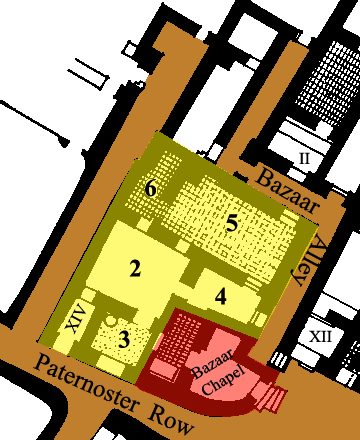
A number of domestic houses were extensively remodelled and turned into business enterprises during this period. No. 14 Paternoster Row (AH) was converted into a ‘fast-food’ restaurant. A bread oven was built in the corner of the front room (Room 3) so that the food could be prepared in full view of passers-by and sold over the counter. At some point, a hatch was cut through the wall of the courtyard (2) to the old domestic chapel (Room 5). Woolley suggests that this was done to provide indoor seating.
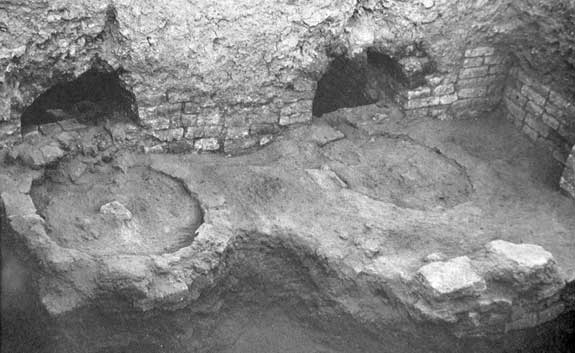
Remains of two furnaces in Room 1, No. 1b Baker's Square
The house at No. 1B Baker’s Square (AH) had been converted into some sort of manufacturing business. The entrance passage led to an open court which contained a pair of large furnaces. The stoke holes for these were in an adjacent room (3) which also contained the opening to another furnace in Room 4. A view of Room 3 can be seen in the title shot. Between the stoke holes was a 1 metre square basin completely paved and edged with baked bricks. What appeared to be lime was found nearby. The walls ofthe three rooms at the back of the house (Rooms 2, 5 & 6) were razed to turn the whole area into one large courtyard. Miniature tools found in a grave beneath the house may represent those of acoppersmith.
No. 1 Broad St. (AH) had been remodelled so that the courtyard and guest room could be used as a school. Over 2000 exercise tablets; math tables; religious texts and copy inscriptions were found. A geometry text from Tell Harmal is shown (left). The teacher was apparently a man named Imgil-Sin since letters addressed to him were found in the building. An alik Tilmun named Eanasir lived at 7 Church Lane. An alik Tilmun (literally “one who travels to Dilmun”) was the Babylonian term for a merchant. Dilmun, the island of Bahrein in the Persian Gulf, was an important trading centre in the region, a place where goods from India and southeast Asia were exchanged. Much of his business correspondence has survived indicating he was in the copper trade.
No. 11 Paternoster Row was far and away the largest house found having no less than 19 ground floor rooms. It is also unusual in that it had three separate entrances, side by side, along Paternoster Row. Woolley reckons it must have been three storeys high and thought it was most likely a ‘Khan’, the sort of inn that was common in the Middle East in his day. However, there is no direct evidence of this.

